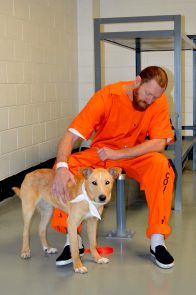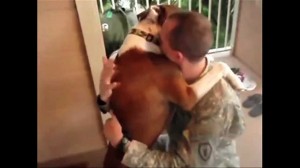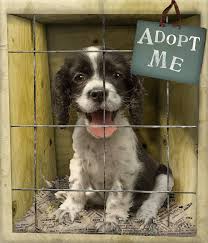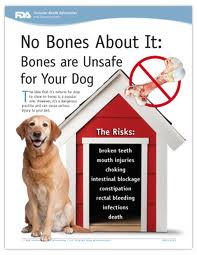Archive for November, 2013
Training a Service Dog…In a Prison
 There are a variety of ways to become involved in training a service dog. One unique way that benefits the dog and the training is through inmates. When given the opportunity to train future service dogs, inmates gain confidence, learn how to handle responsibility and develop a valuable emotional bond with the animal. They also gain training and grooming expertise. Abilities that may help them find jobs when they leave prison. It’s an idea that seems to be working. Released inmates that have trained dogs have high employment and low rates of returning to a life of crime. The dog’s benefit to. Most are rescue dogs that need attention and obediance training. Many go on to become valuable service or therapy dogs. So if your ever visiting anyone in prison, don’t be surprised if you see some prisoners with dog leashes and dogs training.
There are a variety of ways to become involved in training a service dog. One unique way that benefits the dog and the training is through inmates. When given the opportunity to train future service dogs, inmates gain confidence, learn how to handle responsibility and develop a valuable emotional bond with the animal. They also gain training and grooming expertise. Abilities that may help them find jobs when they leave prison. It’s an idea that seems to be working. Released inmates that have trained dogs have high employment and low rates of returning to a life of crime. The dog’s benefit to. Most are rescue dogs that need attention and obediance training. Many go on to become valuable service or therapy dogs. So if your ever visiting anyone in prison, don’t be surprised if you see some prisoners with dog leashes and dogs training.
Remember, your pets count!
Popular Standards, like Sinatra, Billie Holliday, Tony Bennet, Bing Crosby all the time on STARLITE 365. You can find this and five other great stations on THE EDGEWATER INTERNET RADIO NETWORK!
Military Reunions with Man’s Best Friend, Do Our Furry Friends Have a Sense of Time?
 On Veterans Day we honor all of our military who have given the ultimate sacrifice for their country. While they were away, they were missed by their family, friends and loved ones. Included in that group are their beloved pets. Thousands of dogs and cats reunite with our vets everyday. How many times have you heard that dogs have no sense of time? I believe that they do have some sense of time, maybe it’s not the same as ours. Their was a study done where the researcher recorded the behavior of dogs left by their owners for 30 min, 2 hours and 4 hours, and found that if the dogs had been left alone for 2 or 4 hours they greeted their owners with more ‘intensity,’ and were more active and attentive, than when the duration of separation had only been 30 minutes. However, there was no statistical significance between the dogs behavior if left alone for 2 or 4 hours. So when you arrive home from the service after six months or a year, expect lots of jumping and big sloppy kisses from your furry friend. He really missed you!
On Veterans Day we honor all of our military who have given the ultimate sacrifice for their country. While they were away, they were missed by their family, friends and loved ones. Included in that group are their beloved pets. Thousands of dogs and cats reunite with our vets everyday. How many times have you heard that dogs have no sense of time? I believe that they do have some sense of time, maybe it’s not the same as ours. Their was a study done where the researcher recorded the behavior of dogs left by their owners for 30 min, 2 hours and 4 hours, and found that if the dogs had been left alone for 2 or 4 hours they greeted their owners with more ‘intensity,’ and were more active and attentive, than when the duration of separation had only been 30 minutes. However, there was no statistical significance between the dogs behavior if left alone for 2 or 4 hours. So when you arrive home from the service after six months or a year, expect lots of jumping and big sloppy kisses from your furry friend. He really missed you!
Remember, your pets count!
Listen to great music on THE EDGEWATER INTERNET RADIO NETWORK!
Do Cats and Rabbits Get Along?
 I once had a rabbit as a pet. Her name was Max (short for Maxine). I later brought my cat Molly home. At the time, Molly was only five weeks old and I was concerned about how they would get along once Molly got older. It was very surprising to see that the two got along just fine. In fact, Molly got along much better with Max then she does with my younger cat, Millie.
I once had a rabbit as a pet. Her name was Max (short for Maxine). I later brought my cat Molly home. At the time, Molly was only five weeks old and I was concerned about how they would get along once Molly got older. It was very surprising to see that the two got along just fine. In fact, Molly got along much better with Max then she does with my younger cat, Millie.
Although they are enemies in the wild, domestic rabbits and cats can be friends in the home. When introduced to each other in the right conditions, these animals can become amicable roommates. However, proper precaution should always be taken to keep both pets safe and happy. The best time to have them meet would be when both are babies. That way, they can grow up together and will never know a world that doesn’t include each other. This is a common way to get animals of different species to get along. The combination works best when the cat is calm and submissive and the rabbit is assertive. This was the cat with Molly and Max. Max ruled the roost!
The best way to introduce them is to begin with some brief meetings. Keep some form of separation between them Remove one of the animals from the meeting if he seems overly scared or is about to lash out. Slowly increase the animals’ time together until they reach the point they are no longer disturbed by one another’s presence.
Good luck with your cat/rabbit combo!
Remember, your pets count!
Soft Rock perfect at work on MOVIN EASY NET RADIO! You’ll love it. Leave it on all day with no repeats. It can be found on i-tunes, live 365 and THE EDGEWATER INTERNET RADIO NETWORK!
No Kill Policy for Animal Shelters
 Did you know that if every animal shelter in the United States a no kill philosophy as well as all of the services and programs to make if possible, we would save nearly four million dogs and cats who are scheduled to die in shelters this year and each year after that? There are organizations that support this kind of thinking. It’s is really important to do everything we can to save the innocent pets that wind up at shelters. One organization is called The No Kill Network. They help promote a no kill model and strive to get all animal shelters to follow it. Here is their mission statement.
Did you know that if every animal shelter in the United States a no kill philosophy as well as all of the services and programs to make if possible, we would save nearly four million dogs and cats who are scheduled to die in shelters this year and each year after that? There are organizations that support this kind of thinking. It’s is really important to do everything we can to save the innocent pets that wind up at shelters. One organization is called The No Kill Network. They help promote a no kill model and strive to get all animal shelters to follow it. Here is their mission statement.
The nØkill Network is dedicated to promoting no-kill animal shelters, organizations, and rescue groups by helping people learn about and locate these organizations. The nØkill Network also strives to promote the no-kill model so that shelters that do not currently have a no-kill policy might take the initiative needed to gain the public, governmental, and financial support necessary to become a no-kill organization. Shelters that historically euthanized healthy, adoptable animals have been able to make this change – it is possible and we hope that this community can help to provide the ideas, education, and support necessary to make it happen for the rest of the shelters throughout the nation. Please join the community to learn, participate, and support the mission!
To find out more about the No Kill Network , visit their website at: http://www.nokillnetwork.org/
Lets try to help save more pet lives this year!
Remember, your pets count!
Listen to great radio stations on our network. THE EDGEWATER INTERNET RADIO NETWORK.
Chew Toys Can Be Good For Your Dog But…..The Right Ones
 You love to see your dog settle down with his favorite chew toy. He’s not only exercising his jaws but he’s getting a mental workout as well. We can easily get into a good book but your dog explores his world with his mouth which benefits his brain explains Kristen Collins, an animal behaviorist from the ASPCA behavior team. If your dog has plenty of supervised chew toy time, it will help stop him from turning to chewing some of your favorite things like your furniture, TV remote etc.
You love to see your dog settle down with his favorite chew toy. He’s not only exercising his jaws but he’s getting a mental workout as well. We can easily get into a good book but your dog explores his world with his mouth which benefits his brain explains Kristen Collins, an animal behaviorist from the ASPCA behavior team. If your dog has plenty of supervised chew toy time, it will help stop him from turning to chewing some of your favorite things like your furniture, TV remote etc.
Chew toys must be safe and vinyl toys don’t carry a warning label. So look for toys designated “phthalate free,” a claim that is government regulated, or check with the manufacturer. According to Prevention, many chew toys are made from polyvinyl chloride, also known as PVC or vinyl—a cheaply manufactured rubbery plastic. While the texture may be ideal for chewing, what lurks inside is not: The chemicals that give this plastic its chewy quality are known as phthalates. According to one Danish study that examined the effects of these on pets, the grinding, heat, and moisture associated with chewing breaks down the plastics, depositing phthalates into your dog’s body and increasing his risk of liver, kidney, and reproductive problems.
Get the right chew toys for your pet to keep him busy and improve his brain function!
Remember, your pets count!
Rock and Alternative on LINDBERGH MIX RADIO. Find this and five other great stations on THE EDGEWATER INTERNET RADIO NETWORK!
Moving to a New Home with Your Cat
 Cats are not big fans of change. If they could chose, they would prefer to stay where they’re already comfortable and settled in. You should try to make the move as stress free as possible, It can have big benefits including house soiling, excessive meowing and crying, hiding, escape attempts and aggression. There are three basic components to moving to a new home with a cat. The first is pre-move preparations, then the move itself and finally settling into your new home with your cat. Here are some tips to remember.
Cats are not big fans of change. If they could chose, they would prefer to stay where they’re already comfortable and settled in. You should try to make the move as stress free as possible, It can have big benefits including house soiling, excessive meowing and crying, hiding, escape attempts and aggression. There are three basic components to moving to a new home with a cat. The first is pre-move preparations, then the move itself and finally settling into your new home with your cat. Here are some tips to remember.
- Make sure that your cat is used to his carrier. Put the carrier out, open the door and put some food outside the carrier. Then eventually move the food inside the carrier. Make her feel like the carrier is part of her home.
- Put out your moving boxes a couple of weeks before you begin packing. If your cat is nervous while you’re packing,she’ll probably be happier closed in a quiet room, away from the activity and the noise.
- Try to keep your cat’s daily routine as stable as possible. Stick closely to her regular schedule for feeding, play and attention. A feeder with a timer can be helpful to make sure your cat eats at the same time each day.
- If your cat is very skiddish, speak to your vet about some anti-anxiety medication.
The following information was provided by Web MD
The Move
- To prevent your cat from dashing out the door while movers are going in and out, close him in a bathroom with food, water, a bed and litter box. Place a sign on the door asking the movers to keep the door shut.
- Feed your cat a very small breakfast on moving day to reduce stomach upset.
- While in transit, resist the urge to open your cat’s carrier to soothe him. A scared cat may try to dash out. Only open the carrier in a secure area and when absolutely necessary.
- Carry a roll of packing tape in case the carrier needs emergency repairs along the way.
Allow you cat to wander around your new home. Show him where his food and litter box is and before you know it, she will be just as comfortable as she was in your old home.
Remember, your pets count!
JUST CLICK ON THE EDGEWATER INTERNET RADIO NETWORK FOR SIX GREAT RADIO STATIONS TO CHOOSE FROM!
Is You Dog Running in Circles and Chasing His Tail?
 What are the reasons for your dog’s repetitive behavior? It’s not uncommon for your puppy to chase it’s tail but tail chasing or tail licking should not consume a large portion of your dogs time. Valarie Tines is an Animal Behaviorist from Fort Worth, Texas. She says that this can be the one behavior problem that is most likely related to pain or neuropothy or even just mild itchiness. She also says that if this is not the true underlying cause, there’s a good chance that there’s probably an underlying neurophysiological disfunction that’s causing the problem. If you see him licking or chasing his tail and you cannot stop him, ask your vet to examine him. If no underlying injuries or allergies can be found, anti anxiety pet medication may be prescribed.
What are the reasons for your dog’s repetitive behavior? It’s not uncommon for your puppy to chase it’s tail but tail chasing or tail licking should not consume a large portion of your dogs time. Valarie Tines is an Animal Behaviorist from Fort Worth, Texas. She says that this can be the one behavior problem that is most likely related to pain or neuropothy or even just mild itchiness. She also says that if this is not the true underlying cause, there’s a good chance that there’s probably an underlying neurophysiological disfunction that’s causing the problem. If you see him licking or chasing his tail and you cannot stop him, ask your vet to examine him. If no underlying injuries or allergies can be found, anti anxiety pet medication may be prescribed.
Remember, your pets count!
There are six great radio stations on THE EDGEWATER INTERNET RADIO NETWORK. Great for work, home or anywhere. If you’re a music ;over, check us out!
Dog Breeds That Are Good For Seniors
 Pets always provide great companionship for senior citizens.They relieve the boredom and feelings of helplessness that is oftentimes associated with older adults who live alone. When shopping for a breed that would best suit a senior citizen, a lot of thought should go into selecting the most appropriate breed. If the senior is fairly sedentary, don’t choose a large dog that requires a lot of exercise. Several breeds because of their size and temperament would make perfect companions for our seniors. Pugs are little dogs with a very sweet disposition that thrive on the attention of their owners. They are very loving and affectionate. They require very little grooming although some have a tendency to be overweight.
Pets always provide great companionship for senior citizens.They relieve the boredom and feelings of helplessness that is oftentimes associated with older adults who live alone. When shopping for a breed that would best suit a senior citizen, a lot of thought should go into selecting the most appropriate breed. If the senior is fairly sedentary, don’t choose a large dog that requires a lot of exercise. Several breeds because of their size and temperament would make perfect companions for our seniors. Pugs are little dogs with a very sweet disposition that thrive on the attention of their owners. They are very loving and affectionate. They require very little grooming although some have a tendency to be overweight.
Schnauzers are small very energetic, spunky and very intelligent. They get along well with other dogs and people including children. They are very territorial and make excellent watchdogs for seniors. They tend to have very happy personalities and require daily brushing and walking for exercise.
Shih-Tzu’s are known for there sweet tempers and overwhelming friendliness. They are perfect indoor pets but they do have long hair that should be kept short to avoid lots of grooming hassles. They require very little exercise and a daily walk will usually suffice.
Cocker Spaniels are very happy dogs and make excellent companions. They need to to be brushed daily and also should be given daily exercise. They are excellent hunters and make good watchdogs.
The pup chosen by more seniors than most other breeds, is the Chihuahua. These are very small, intelligent dogs who make wonderful companions for seniors because they tend to form a bond with there owners. They have frisky personalities and are very territorial and make excellent inside watchdogs. They are very easy to train, require little grooming and exercise.
There are many more breeds that would be very suitable for senior citizens but make sure that you do your research and select the pet that would best suit your lifestyle.
Remember, your pets count!
Great popular standards all the time on STARLITE 365. It could be found on i-tunes and THE EDGEWATER INTERNET RADIO NETWORK.
Which Bones Are Safe For Your Dog?
 Believe it or not, feeding your dog bones is not safe for your dog. Pieces of bone can get logged in a dogs intestine and cause some real damage. According to the FDA, here are 10 reasons why bones are not good for your dog. Read this and decide for yourself. There are many safe dogs treats that are available. Feed your dog a good diet and give him safe snacks and I’m sure that he will not even miss the bones!
Believe it or not, feeding your dog bones is not safe for your dog. Pieces of bone can get logged in a dogs intestine and cause some real damage. According to the FDA, here are 10 reasons why bones are not good for your dog. Read this and decide for yourself. There are many safe dogs treats that are available. Feed your dog a good diet and give him safe snacks and I’m sure that he will not even miss the bones!
Here are 10 reasons why it’s a bad idea to give your dog a bone:
- Broken teeth. This may call for expensive veterinary dentistry.
- Mouth or tongue injuries. These can be very bloody and messy and may require a trip to see your veterinarian.
- Bone gets looped around your dog’s lower jaw. This can be frightening or painful for your dog and potentially costly to you, as it usually means a trip to see your veterinarian.
- Bone gets stuck in esophagus, the tube that food travels through to reach the stomach. Your dog may gag, trying to bring the bone back up, and will need to see your veterinarian.
- Bone gets stuck in windpipe. This may happen if your dog accidentally inhales a small enough piece of bone. This is an emergency because your dog will have trouble breathing. Get your pet to your veterinarian immediately!
- Bone gets stuck in stomach. It went down just fine, but the bone may be too big to pass out of the stomach and into the intestines. Depending on the bone’s size, your dog may need surgery or upper gastrointestinal endoscopy, a procedure in which your veterinarian uses a long tube with a built-in camera and grabbing tools to try to remove the stuck bone from the stomach.
- Bone gets stuck in intestines and causes a blockage. It may be time for surgery.
- Constipation due to bone fragments. Your dog may have a hard time passing the bone fragments because they’re very sharp and they scrape the inside of the large intestine or rectum as they move along. This causes severe pain and may require a visit to your veterinarian.
- Severe bleeding from the rectum. This is very messy and can be dangerous. It’s time for a trip to see your veterinarian.
- Peritonitis. This nasty, difficult-to-treat bacterial infection of the abdomen is caused when bone fragments poke holes in your dog’s stomach or intestines. Your dog needs an emergency visit to your veterinarian because peritonitis can kill your dog.
Remember, your pets count!
Great music all the time on the EDGEWATER INTERNET RADIO NETWORK! Click and enjoy!
Saved By Molly
 My alarm clock usually goes off every weekday morning at 5:45 am. This gives me enough time to get ready and get to work on time. About two nights ago, we lost power in the middle of the night which did something to the alarm clock. When we did regain power, my alarm did not go off. As I was comfortably snoring and was not about to wake up anytime soon, my cat Mollie had to step in and do the job. She got on my nightstand and began knocking things off to get my attention. I heard her but I figured that she just wanted an early breakfast. She then began poking me with her paw. When I didn’t respond, she got on my back and began tugging at the sheets. I finally woke up and realized that the alarm never went off and I was ten minutes behind schedule. I quickly jumped out of bed and began my morning routine. Thanks to Molly for keeping me in check again. I got to work on time and Molly continued with her day, sleeping, sleeping and more sleeping. Sometimes I wish I had a cats life!
My alarm clock usually goes off every weekday morning at 5:45 am. This gives me enough time to get ready and get to work on time. About two nights ago, we lost power in the middle of the night which did something to the alarm clock. When we did regain power, my alarm did not go off. As I was comfortably snoring and was not about to wake up anytime soon, my cat Mollie had to step in and do the job. She got on my nightstand and began knocking things off to get my attention. I heard her but I figured that she just wanted an early breakfast. She then began poking me with her paw. When I didn’t respond, she got on my back and began tugging at the sheets. I finally woke up and realized that the alarm never went off and I was ten minutes behind schedule. I quickly jumped out of bed and began my morning routine. Thanks to Molly for keeping me in check again. I got to work on time and Molly continued with her day, sleeping, sleeping and more sleeping. Sometimes I wish I had a cats life!
Remember, your pets count!
Listen to six great radio stations — oldies–country–soft rock—dance—-pop standards—-alternative. There all on THE EDGEWATER INTERNET RADIO NETWORK!